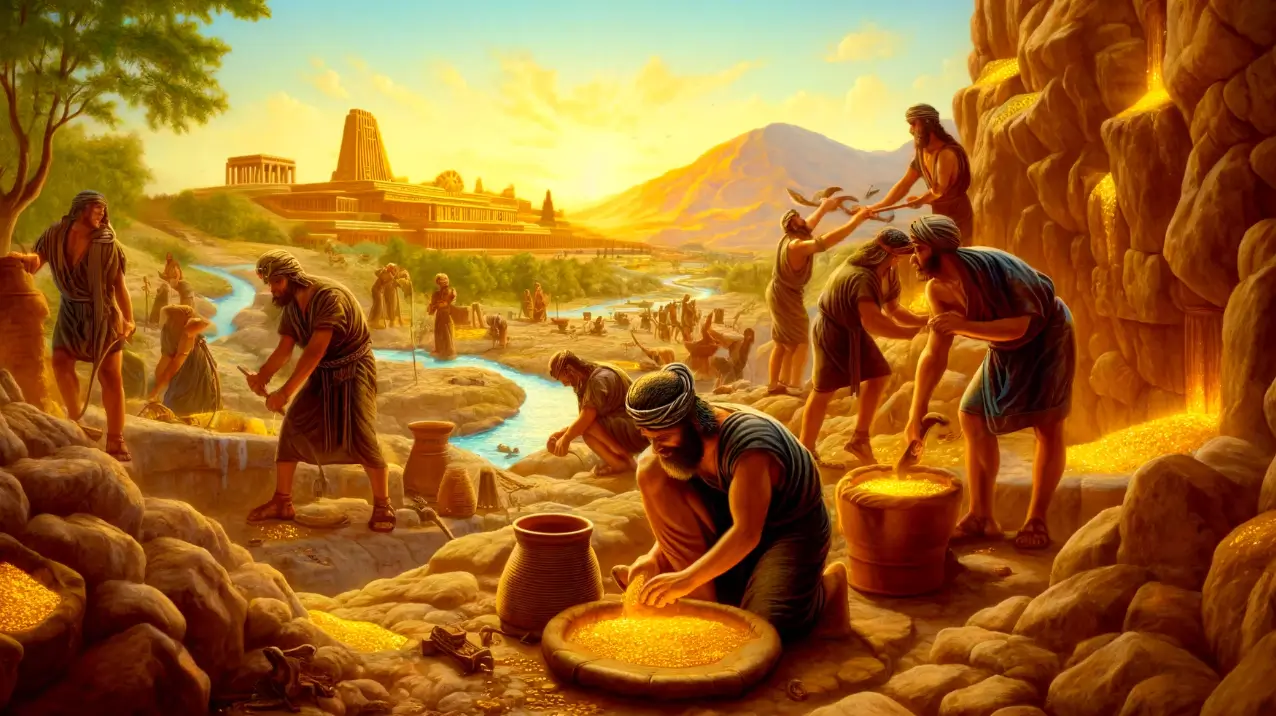Have you ever wondered how ancient civilizations in Mesopotamia, the birthplace of civilization, found their shiny treasures before modern times?
Looking into the history of gold mining in Mesopotamia, from the 4th to the 1st millennium BCE, gives us a peek into their world. Gold was more than just wealth and power; it shaped their culture and economy.
At sites like Ur, Kish, and Nippur, we see the amazing skill of Mesopotamian craftsmen. Recently, about 50 gold pieces from Kish were analyzed at the Field Museum in Chicago. This used Laser Ablation Mass Spectrometry.
This research was backed by an NSF grant. It showed that some gold from Ur came from Iran and Afghanistan’s rich deposits.
The designs on these artifacts are stunning, mixing materials like lapis lazuli from Afghanistan and carnelian from the Indus valley. This shows a vast trade network. Also, earrings with unique shapes found in Iraq, Syria, and Georgia highlight Mesopotamia’s influence and trade.
Key Takeaways about Uncovering Gold Mining in Ancient Mesopotamia
- Artifacts span from the 4th to the 1st millennium BCE, showcasing Mesopotamian gold history.
- Approximately 50 gold artifacts from Kish were analyzed using advanced technologies.
- Studies funded by the NSF revealed rich gold deposits in Iran and Afghanistan.
- Mesopotamian gold artifacts often combine with materials like lapis lazuli and carnelian.
- Long-distance trade routes facilitated extensive interactions and economic ties.
Introduction to Gold Mining in Ancient Mesopotamia
Gold mining has a storied past, tracing back through the centuries in numerous ancient civilizations. The history of Mesopotamian gold is particularly rich, with artifacts from the 3rd millennium BCE demonstrating the advanced ancient gold mining techniques used in this region. Spread across sites such as Ur, Kish, and Nippur, these artifacts reveal the significant impact gold had on the economy and culture of Mesopotamian society.
The analysis of gold artifacts, including those from Hissar and Gawra in modern Iraq, has provided a deeper understanding of gold extraction in ancient times. Notable analysts like Moritz Jansen, Andreas Hauptmann, Sabine Klein, and Laure Dussubieux have utilized sophisticated methods like geochemistry to examine trace elements and isotopes. Their studies have shed light on the circulation and exchange of gold within and beyond Mesopotamian borders.
In 2018, research focusing on approximately 50 artifacts from Kish was carried out using Laser Ablation Mass Spectrometry, revealing potential alluvial deposits in Iran and Afghanistan as gold sources. This finding emphasizes the extensive trade networks that existed in ancient Mesopotamia, facilitating the movement of valuable resources over long distances.
Mesopotamian gold mining historically used manual separation processes such as gold panning for alluvial deposits. With the expansion to deeper ores, more complex methods like pit mining and gold cyanidation were introduced. The significance of gold extended beyond mere economic value; it was also pivotal in religious and cultural contexts, symbolizing wealth and power for millennia.
Historical Context of Mesopotamian Gold Artifacts
Gold played a vital role in Mesopotamia, reflective of both wealth and power. By examining gold artifacts from key archaeological sites, we gain insight into the Mesopotamian era. The sites of Ur, Kish, and Nippur have been instrumental in providing information about how gold was used and traded during different periods.
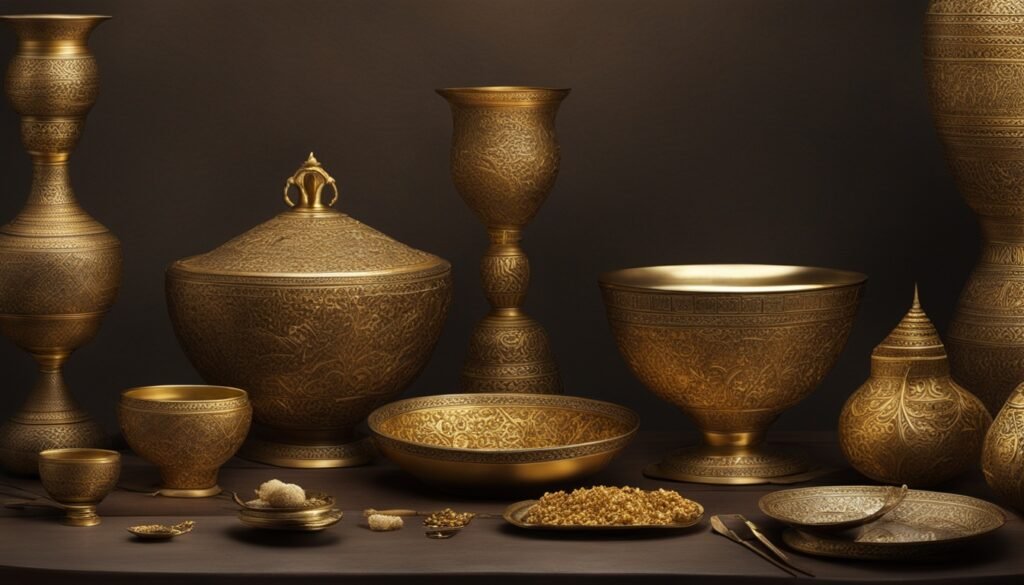
Key Sites: Ur, Kish, Nippur
The significance of Ur, Kish, and Nippur cannot be understated. These key archaeological sites have yielded numerous gold artifacts that span from the 4th to the 1st millennium BCE. Artifacts analyzed from the 1920s-30s excavations at Kish include about 50 gold items studied in 2018 using Laser Ablation Mass Spectrometry. These sites, located in present-day Iraq, are central to understanding the distribution and use of gold in ancient Mesopotamia.
Date Range: 4th to 1st Millennium BCE
The gold artifacts from Mesopotamia date from the 3rd millennium BCE but include finds from as early as the 4th millennium and as late as the 1st millennium BCE. The timeline of these artifacts helps trace the evolution of gold usage and its cultural significance. Through the geochemical analysis techniques employed by researchers such as Moritz Jansen, Andreas Hauptmann, Sabine Klein, and Laure Dussubieux, we are able to characterize the elements composing these artifacts and understand their origins.
Buy Gold Online: The Smart and Secure Way
Discover the safest and most reliable strategies to buy gold online. Make informed investment decisions and secure your financial future today!
Learn MoreThe discoveries from these archaeological sites highlight the thriving trade networks that existed in Mesopotamia since the 3rd millennium BCE. The analyses, partly funded by an NSF subsidized grant program at the Field Museum, have revealed intricate connections between distant regions, further illustrating the complexity of Mesopotamian trade and the high value placed on gold. Understanding these long-distance trade networks has been crucial in comprehending how gold, among other materials, was exchanged and integrated into Mesopotamian culture.
The Geochemical Analysis of Gold Artifacts
The geochemical analysis of gold artifacts offers invaluable insights into the elemental and isotopic compositions of these ancient treasures. Artifacts analyzed under this study were produced in the 3rd millennium BCE, with additional items dating from the 4th to the 1st millennium BCE. Such artifacts originate from key Mesopotamian sites like Ur, Kish, Nippur, Hissar, and Gawra in modern-day Iraq.
Trace Elemental and Isotope Composition
Through detailed studies, scientists have identified the trace elemental composition of gold artifacts, including inclusions of Platinum Group Elements (PGE) like osmium, iridium, and ruthenium. For instance, the main alloying constituents in the artifacts from Ur include osmium (26–70 wt.%), iridium (14–26 wt.%), and ruthenium (0.4–45 wt.%). Such compositions enable researchers to determine the origins and trading routes of ancient gold specimens.
The PGE inclusions, which can reach sizes of up to 200 microns, indicate the use of placer gold as raw material. This presence can suggest either a single primary source or multiple primary sources within regions rich in alluvial gold deposits, such as Iran and Afghanistan.
Methods: Laser Ablation Mass Spectrometry
In 2018, nearly 50 gold artifacts from the Field Museum in Chicago underwent analysis through Laser Ablation Mass Spectrometry. This advanced technology enabled a non-destructive examination of the gold artifacts’ geochemical compositions, which is crucial for identifying their provenance. Laser ablation spectrometry gold techniques allow for precise isotope analysis gold results, further aiding the understanding of ancient trade networks and mining practices.
Moreover, the inclusion of lapis lazuli from Afghanistan and carnelian likely imported via the Indus Valley in Mesopotamian gold artifacts signifies rich and far-reaching trade networks that were integral to the ancient civilization’s wealth and power.
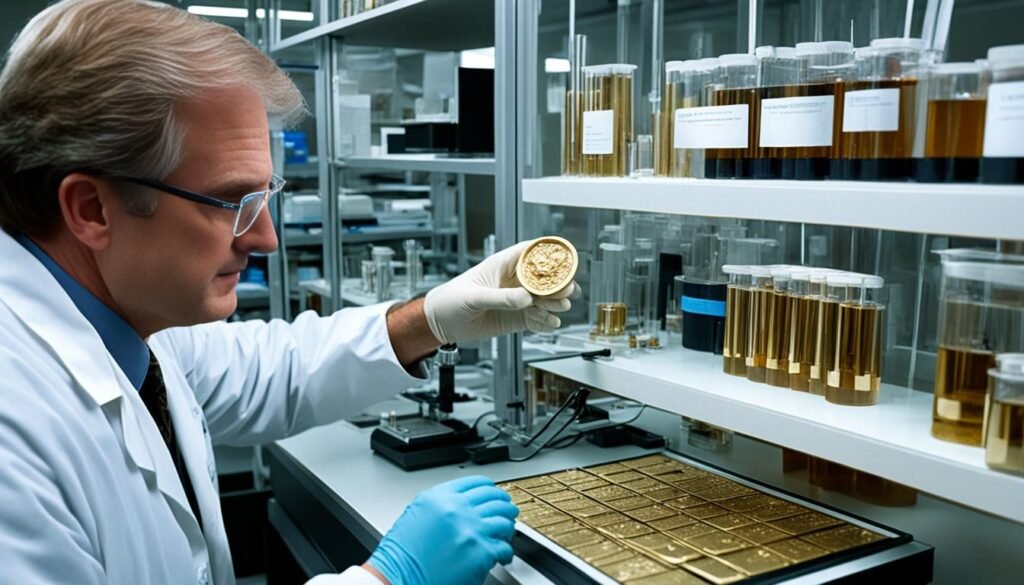
| Artifact Category | Elemental Inclusions | Average Composition (wt.%) |
|---|---|---|
| Vessels | Osmium | 26–70 |
| Weapons | Iridium | 14–26 |
| Jewelry | Ruthenium | 0.4–45 |
| Beads/Rings | Platinum | 0.3–6.7 |
| Hair Ornaments | Rhodium | 0.1–2.1 |
Theories on the Origin of Mesopotamian Gold
The origin of Mesopotamian gold is a subject of extensive research and debate. Scholarly efforts have aimed to ascertain whether the ancient gold sources were primarily from alluvial deposits or hard rock mining. Given Mesopotamia’s lack of significant native gold deposits, these theories are crucial for understanding the procurement methods in ancient times.
Alluvial vs. Hard Rock Deposits
Exploring the origin of Mesopotamian gold involves examining alluvial gold deposits and hard rock gold mining. Alluvial gold, found in riverbeds, is easier to extract and was likely one of the earliest sources utilized. Conversely, hard rock gold mining requires advanced techniques, indicating a more developed understanding of geology and mining practices.
Potential Sources: Iran and Afghanistan
Archaeological evidence points to Iran and Afghanistan as potential primary sources of Mesopotamian gold. Raw blocks of lapis lazuli transported from northeastern Afghanistan to Mesopotamia underscore the established trade routes that could have also included gold. The robust trading network, extending 400 miles from Ur to the bustling seaport of Dilmun in present-day Bahrain, facilitated the exchange of luxury goods, including gold, across vast distances.
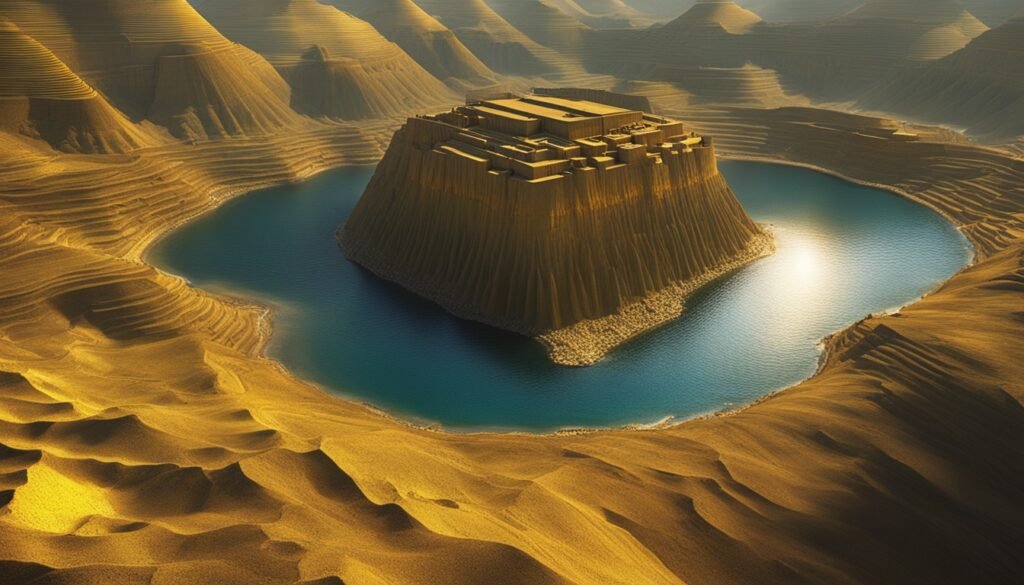
Examining these theories highlights the importance of both alluvial gold deposits and hard rock gold mining in the procurement of gold for Mesopotamian civilizations. Trade routes extending to regions rich in mineral resources allowed Mesopotamia to thrive and accumulate wealth, showcasing the sophistication and reach of their ancient economy.
| Trade Good | Source | Route |
|---|---|---|
| Lapiz Lazuli | Afghanistan | By foot or donkey |
| Wood | Iran | Overland |
| Ivory | Africa & Indus Valley | By sea and land |
| Gold | Potentially Iran & Afghanistan | Through established trade networks |
Cultural Significance of Gold in Mesopotamia
Gold in Mesopotamia transcended its material value, becoming a profound symbol of divine connection, power, and prestige. The artifacts crafted from gold reflect the ancient civilizations value of gold, which was intricately woven into their cultural and religious fabric. Often, these objects were not just luxurious items but held significant ceremonial importance.
Gold artifacts from Mesopotamia, primarily those produced during the 3rd millennium BCE, showcase the brilliance of craftsmanship spread across sites like Ur, Kish, and Nippur in modern-day Iraq. The diversity and sophistication of these artifacts underline the gold symbol Mesopotamia civilizations placed upon this precious metal. Penn Museum’s recent analyses highlight the extensive use of gold combined with lapis lazuli and carnelian, materials which were sourced from distant regions like Afghanistan and the Indus valley, reflecting a complex network of trade.
Items unearthed from sites such as Kish and Ur illustrate how gold was deployed in various forms – from dining utensils and jewelry to ornate religious objects. These artifacts, including those that formed part of elaborate burial customs, powerfully convey the ancient civilizations value of gold. The findings from Ur, in particular, offer a glimpse into Sumerian burial traditions, where elite individuals were adorned with gold items, underscoring the metal’s prestigious and divine connotations.
The consolidation of gold with other precious materials not only accentuates its cultural importance but also signifies Mesopotamia’s extensive trade connections with neighboring regions. The Field Museum’s examination of around 50 gold artifacts using Laser Ablation Mass Spectrometry further unearths the geographical origins of these materials, identifying regions in Iran and Afghanistan as primary sources. These details not only enhance our understanding of gold’s cultural significance but also reveal the intricate web of ancient trade networks.
The Sumerians’ use of gold to create stunning filigreed jewelry, chains, and headdresses for both secular and sacred purposes illustrates the metal’s esteemed status. Unlike modern usage, gold was not a currency in Sumer; instead, it held a critical role in their societal and religious domains. This profound cultural narrative of gold symbol Mesopotamia echoes through the exquisite artifacts discovered, providing a testament to its lasting legacy in ancient civilizations.
Trade Networks and Gold Distribution
Examining the distribution of gold during ancient times, it’s evident that trade networks played a pivotal role in Mesopotamian civilization interactions. Local trade in ancient Mesopotamia commenced during the Ubaid Period (c. 5000-4100 BCE), gradually evolving into long-distance trade by the Uruk Period and reaching its zenith during the Early Dynastic Period.
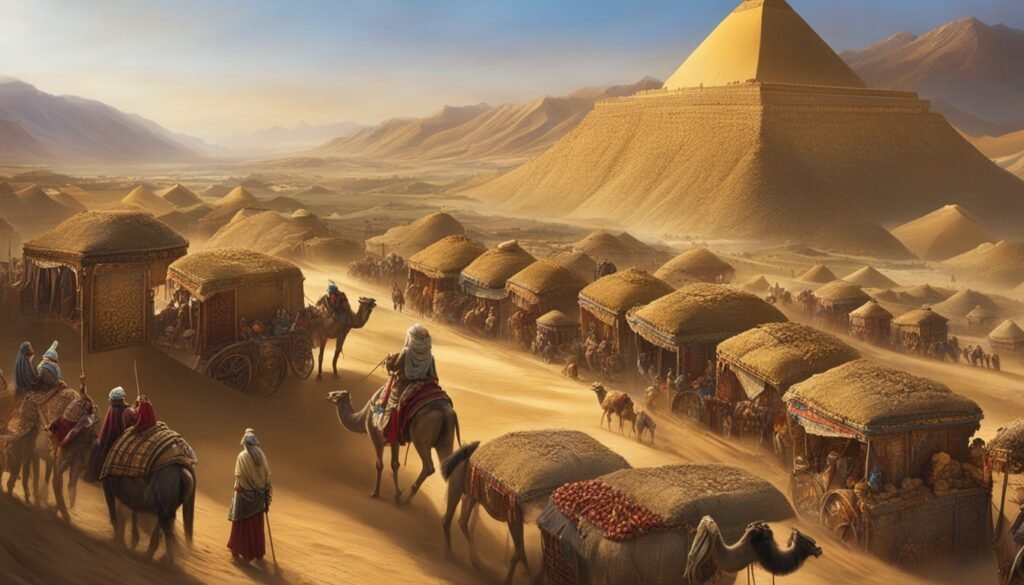
Long-Distance Trade Routes
The extensive Mesopotamian trade routes connected local economies with far-reaching regions. Goods such as ceramics, textiles, and grain were exported, while essential items like gold, silver, copper, ivory, and precious stones were imported. Trade routes along the Tigris and Euphrates Rivers reached the Persian Gulf, linking with notable trade hubs like Dilmun. This facilitated the ancient gold trade, making gold not only a local commodity but also a widespread trade item.
Interaction with Neighboring Civilizations
The interplay between Mesopotamian civilization interactions and neighboring cultures was greatly influenced by trade. For instance, Mesopotamians imported luxury goods from Egypt and precious metals from the Indus Valley and Asia Minor. The Akkadian Empire (2334-2218 BCE) further bolstered these trade relations by regulating commerce, standardizing prices and practices, and improving infrastructure. This robust network not only facilitated the flow of material goods but also influenced art and architecture across regions. Nearly half of the artifacts at the Metropolitan Museum of Art’s “Art of the First Cities” exhibition exemplify these cultural exchanges, linking Mesopotamian artifacts with those from Troy, Greece, and the Indus Valley.
| Trade Commodity | Exported Goods | Imported Goods |
|---|---|---|
| Food & Textiles | Grain, Palm Oil, Textiles | Barley, Metals |
| Crafts | Ceramics, Reed Baskets, Leather Products | Precious Stones, Lapis Lazuli |
| Metals | Glass Products, Fish | Gold, Silver, Copper, Ivory |
This evidence highlights how Mesopotamian trade routes significantly contributed to the distribution of gold and the interaction between various ancient civilizations. Such networks were paramount in transitioning gold from a local resource to a highly valuable trade commodity across these cultures.
Methods of Gold Extraction and Processing
Gold extraction methods have a rich history, dating back at least 6,000 years, with the earliest identifiable finds in Egypt and Mesopotamia around 4000 BC. In ancient times, gold extraction methods and gold processing techniques evolved significantly, reflecting the ingenuity of early miners. By 3000 BC, gold rings were used as forms of payment, underscoring the importance of efficient extraction and processing techniques.
The high density of gold, approximately 19.3 grams per cubic centimeter, made it amenable to recovery using placer mining and gravity concentration techniques. These methods were pivotal in ancient gold extraction practices. Alluvial deposits were often mined for gold, with particles of elemental gold frequently found in river sands. This method of mining was relatively straightforward and exploited the heavy nature of gold compared to other materials.
Another notable advancement in gold processing techniques historical emerged by 2000 BC, where the process of purifying gold-silver alloys with salt to remove silver was developed. This method revealed early metallurgical knowledge and sophistication. Around AD 100, Roman Spain employed up to 40,000 slaves in gold mining operations, indicating the extensive labor required and the value placed on efficient extraction techniques.
The most significant gold deposit discovery occurred in the Witwatersrand region of South Africa, which produced 25% of the world’s gold by 1899 and 40% by 1985. This monumental find highlighted the evolution and advancement of gold processing techniques historical over time. Other regions, including the United States, Brazil, Australia, Canada, and Russia, also hold considerable gold reserves, further demonstrating the global pursuit of gold extraction innovations.
The historical context of gold extraction is rich with various methods employed to harness this precious metal. Ancient miners’ inventive approaches continue to inform modern mining techniques, reflecting an enduring legacy of discovery and adaptation.
Challenges and Questions in Mesopotamian Gold Research
The domain of Mesopotamian gold research is fraught with numerous difficulties and unresolved questions. Understanding the complexities behind ancient mining technique mysteries and the elusive origins of gold reserves requires dedicated efforts from scholars across the globe.
Lack of Native Gold Deposits
A significant obstacle in studying Mesopotamian gold is the apparent lack of native gold deposits within the region. Preliminary analyses show potential sources of alluvial gold in Iran and Afghanistan, but no substantial evidence confirms extensive local gold deposits. This absence complicates efforts to trace the origins of gold artifacts unearthed during excavations. Notably, artifacts such as vessels, weapons, and jewelry from Ur indicate a sophisticated and affluent society, yet the precise sources and trade routes of their gold material remain ambiguous.
Unknown Early Mining Techniques
The challenges extend into the heart of ancient mining technique mysteries. While the project’s primary focus spans artifacts from the 3rd millennium BCE, encompassing periods from the 4th to 1st millennium BCE allows researchers to observe technological transitions over time.
Despite advanced methods like Laser Ablation Mass Spectrometry utilized at the Field Museum in Chicago, there remains a considerable gap in our knowledge of the initial mining methods employed by ancient Mesopotamians.
Were they reliant solely on alluvial deposits, or did they develop rudimentary hard rock mining techniques? These questions still intrigue and baffle modern researchers.
The collaborative efforts between the Penn Museum, German Mining Museum, and the Field Museum underscore the comprehensive approach required to piece together Mesopotamian gold research challenges. Researchers continue to delve into geochemical characterizations and isotopic analyses of gold artifacts from Kish and Ur to gain deeper insights. This multifaceted study not only seeks to unveil the origins and nature of ancient mining techniques but also to map the ancient trade networks facilitated by Mesopotamian trade, transporting valuable metals across vast distances.
The Role of Archaeological Discoveries
The Mesopotamian archaeological excavations have provided profound insights into the ancient civilization’s handling and appreciation of gold. One of the most compelling sites contributing to our understanding is the Royal Cemetery of Ur, which yielded numerous significant artifacts that have reshaped our perception of Mesopotamia.
Key Excavations: The Royal Cemetery of Ur
Renowned excavations at the Royal Cemetery of Ur have unearthed gold artifacts that date back to the 3rd millennium BCE. These findings are pivotal because they shed light on the lives of the elite in ancient Ur. Researchers such as Moritz Jansen, Andreas Hauptmann, Sabine Klein, and Laure Dussubieux have played key roles in these excavations and analyses. The analyses conducted at the Field Museum in 2018 by archaeometallurgist Moritz Jansen, delved into about 50 gold artifacts using advanced techniques like Laser Ablation Mass Spectrometry.
Significant Finds and Their Impacts
The significance of these gold artifacts extends beyond their intrinsic value. Preliminary analyses have identified two rich alluvial deposits in Iran and Afghanistan as potential sources for the gold, reflecting a complex trade system in place thousands of years ago. Such discoveries illustrate the advanced level of craftsmanship and the elaborate trade networks that connected ancient Mesopotamia with distant regions.
This geochemical fingerprinting, supported by sponsors such as Penn Museum and the Field Museum, has enabled us to pinpoint the geological origins of the Royal Cemetery of Ur’s gold artifacts. These revelations underscore the profound importance of these artifacts in our broader understanding of ancient Mesopotamian society.
| Aspect | Details |
|---|---|
| Time Period Studied | 3rd millennium BCE (major focus), with artifacts up to the 1st millennium BCE |
| Key Locations | Ur, Kish, Nippur, Hissar, Gawra in Mesopotamia (modern Iraq) |
| Key Researchers | Moritz Jansen, Andreas Hauptmann, Sabine Klein, Laure Dussubieux |
| 2018 Work | Laser Ablation Mass Spectrometry analysis of about 50 artifacts at Field Museum |
| Sponsors | Penn Museum, Field Museum |
| Geological Origin | Iran and Afghanistan (identified potential sources) |
| Trade Network Evidence | Artifacts suggest connections to regions like Afghanistan and the Indus valley |
Such discoveries significantly advance our knowledge of the gold artifacts’ significance within Mesopotamian archaeology, offering a window into the opulence, trade, and technological advancements of the time.
Gold Mining in Ancient Mesopotamia
Gold played an essential societal role in Mesopotamia, marking it as a material of extraordinary significance. The influence of gold mining on Mesopotamian society was substantial, reflecting both its cultural and economic dimensions.
Importance of Gold to Mesopotamian Society
Gold artifacts unearthed from sites such as Ur, Kish, Nippur, and beyond reveal how gold was intertwined with religious and prestige functions. The royal cemetery at Ur, with its abundance of gold, exemplifies its ceremonial importance. The ancient gold and precious materials found in these contexts highlight the centrality of gold in marking social status and divine favor.
Integration with Other Precious Materials
Gold did not stand alone in its allure. Other ancient gold and precious materials, such as lapis lazuli, carnelian, and chlorite, were also highly prized. Lapis lazuli, found in various artifacts, denotes its value beside gold in the Mesopotamian aesthetic. Carnelian beads and seals point to intricate trade networks and their imported origins. Chlorite stone artifacts, often inlaid with semi-precious stones, highlight the blend of materials that added a multifaceted splendor to Mesopotamian treasures.
In conclusion, the societal role of gold in Mesopotamia was deeply rooted, interwoven with other precious materials, and celebrated through lavish artifacts that have withstood the test of time. The study of these elements reveals a complex societal structure where material wealth was profoundly respected and curated through extensive trade and craftsmanship networks.
For an overview about the Ancient Gold Mining Techniques and History, please check this guide.
Conclusion
The journey through the history of Mesopotamian gold mining has unveiled numerous insights into the ancient world’s methods and significance of this precious metal. The crux of our exploration reveals that gold, with its specific gravity being 19.3 times heavier than water, did not just form mere economic assets but served as a vital cultural symbol.
It was often found in its pure form, commonly accompanied by trace impurities like silver, copper, zinc, and lead. This immutability and rarity positioned gold as a pivotal element of power and prestige, whether it was the monopolistic control of the Pharaohs or its trading value among the Mycenae and Pylos elites.
The geochemical studies and archaeological excavations, especially in sites like Ur, Kish, and Nippur, have provided a comprehensive understanding of how ancient civilizations integrated gold into their societal fabric. Moreover, the influence of neighboring regions, such as the introduction of standardized metal weights by the Lydians in Sardis and the early coinage system around 640 B.C., profoundly affected how gold was perceived and traded, solidifying its legacy in western civilization.
Reflecting on the technical advancements, the amalgamation method, and alluvial gold deposits of Sardis dating back to 700 B.C., we can appreciate the ingenuity of ancient civilizations. These historical contexts enrich our knowledge of gold mining’s role, not just as a trade commodity but as a cornerstone of cultural and economic development.
As we conclude, the legacy of gold in ancient Mesopotamia remains a testimony to human ingenuity and the enduring quest for wealth and symbolic representation.
FAQ about Uncovering Gold Mining in Ancient Mesopotamia
What is the historical significance of gold mining in ancient Mesopotamia?
The exploration of gold mining in Mesopotamia reveals artifacts that span from the 4th to the 1st millennium BCE, highlighting the importance of gold as a symbol of wealth and power in ancient cultures. This played a pivotal role in shaping Mesopotamian society.
Which archaeological sites are crucial for understanding Mesopotamian gold artifacts?
The core archaeological sites of Ur, Kish, and Nippur are essential for understanding Mesopotamian gold artifacts. These sites, with discoveries dating from the 4th to the 1st millennium BCE, offer deep insights into Mesopotamian culture and trade practices.
How do researchers analyze the composition of gold artifacts?
Researchers use geochemical analysis, including trace elemental and isotope composition studies. Technologies like Laser Ablation Mass Spectrometry are critical in pinpointing the origin and age of these gold artifacts, helping us understand ancient trade networks.
What theories exist about the origins of Mesopotamian gold?
There are main theories regarding the origins of Mesopotamian gold. Some suggest it came from alluvial deposits, while others propose hard rock deposits. Iran and Afghanistan are considered potential primary sources of this gold.
What was the cultural significance of gold in Mesopotamia?
In Mesopotamia, gold was not merely material; it symbolized divine connection, power, and prestige. Artifacts often incorporated gold for religious and ceremonial purposes, reflecting its intrinsic cultural value.
How did trade networks facilitate the distribution of gold in Mesopotamia?
Trade networks played a vital role in the distribution of gold in Mesopotamia. Long-distance trade routes facilitated interactions with neighboring civilizations, transforming gold from a local resource into a valuable trade commodity across different societies.
What ancient techniques were used for gold extraction and processing?
Ancient techniques for gold extraction and processing involved both manual extraction and systematic processing methods. These methods evolved over time, highlighting the ingenuity and adaptability of ancient miners.
What challenges do researchers face in Mesopotamian gold research?
Researchers face several challenges, including the lack of native gold deposits and uncertainties surrounding early mining techniques. Piecing together this historical puzzle requires intricate scientific and archaeological studies.
What are some landmark archaeological discoveries related to gold in Mesopotamia?
The Royal Cemetery of Ur is a landmark archaeological discovery, offering significant findings that enhance our understanding of Mesopotamian society and the role of gold within it. Key excavations have unearthed priceless artifacts, impacting our knowledge profoundly.
How did gold influence ancient Mesopotamian society?
Gold played a significant role in Mesopotamian society, indicating wealth and status. It was often integrated with other precious materials such as lapis lazuli and carnelian, revealing complex societal structures and the high value placed on material wealth.
Source Links
- https://www.penn.museum/research/project.php?pid=49
- https://o3mining.com/articles/history-of-mining/
- https://en.wikipedia.org/wiki/Gold_mining
- https://www.worldhistory.org/article/2114/trade-in-ancient-mesopotamia/
- https://www.sciencedirect.com/science/article/abs/pii/S0305440316000418
- https://factsanddetails.com/world/cat56/sub363/item2216.html
- https://brewminate.com/the-mythological-foundation-of-chemical-theories-in-ancient-civilization/
- https://www.usgoldbureau.com/news/post/importance-gold-history-sumerian-roots

